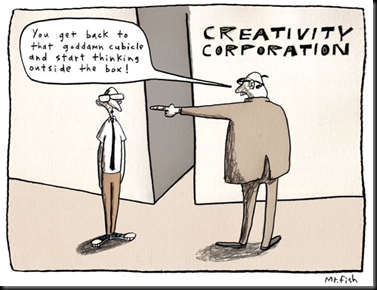The bad thing about creativity is it can't be taught.But the good thing is it can be nurtured and the best thing is everyone has it in one form or other.Creativity is not about colours or images,that's art.Any body who can approach a problem differently can be said creative.A boy/girl who finds new ways to express their love also can be deemed creative.
Garry Burnett give some tips to boost your creativity
- Ask questions- Polaroid cameras were invented when Edward Land's daughter asked him, 'Why do we have to wait to see the photographs?'
- Serendipity - often chance solutions will present themselves - be vigilant - give your mind room to think. Leave something and come back to it - take a walk!
- Avoid functional fixity. Look for the potential alternative uses and applications of everyday objects. Picasso took a bicycle saddle and handlebars and created a bull sculpture.
- Develop structures, experiment with different tools, templates, and forms.
- Ask Mother Nature. Many problems have already been solved by natural solutions (medicine, physics, aerodynamics, etc). Study natural processes for stimulation and inspiration.
- Gather ideas, brainstorm, view no idea as useless, dictate to yourself, tell the story aloud, transcribe your own words and listen to playbacks of your own self-talk. Discuss with students how to fillet out the unnecessary, extraneous ideas in the editing process.
- Play and experiment with associations and ideas. Philo Farnsworth had the idea for television while sitting on a hillside in Idaho looking at the neat rows of a nearby farm. It gave him the idea of creating a picture composed out of dots. He was 14 at the time and after presenting the idea as a science project, spent the next 7 years developing image projection through the cathode ray tube.
- Persist! Never, ever give up. Everything, yes everything, has a solution. Edward de Bono's six hats thinking styles recommends 'green hat' thinking for creativity and innovation. All ideas are accepted without question in the innovatory stages and only really explored in terms of practicability at another stage.
- Fail! Don't be afraid to fail - seek feedback, plan and draft work routinely. View failure as an opportunity to gain 'feedback' and merely a 'setback' to developing greater understanding and insight. Richard Feyman, a Nobel Laureate physicist said, 'To develop working ideas efficiently, I try to fail as fast as I can'.
- Visualise! Use visual organisers and representations, re-order and solution-focus. Imagine the outcome before the work is complete. Einstein famously visualised his experiments eg riding on the end of a light beam to gain insight into time in relativity. Isaac Newton reputedly saw the full moon in the sky at the same time as a nearby apple dropped. This led to him speculating about the laws of universal gravitation and then in turn to developing the laws of mechanics. Eventually this led to him establishing mathematical analysis and modelling as the principal foundations of science and engineering.
- Sleep on it! Activate your creative subconscious, incubate ideas by writing them down and returning to them, daydream. Review your idea or problem just before you go to bed and keep a pad or sound recorder beside the bed and record ideas that 'spontaneously' surface.
- Stimulate your mind with multi-sensory information, have an eye for detail and note down incidents and phrases and keep a diary or notebook to record your research. Borrow ideas to spark your imagination.
This article originally appeared in Teaching Expertise, Issue 11 Spring 2006.


good one and what a timing...
ReplyDelete